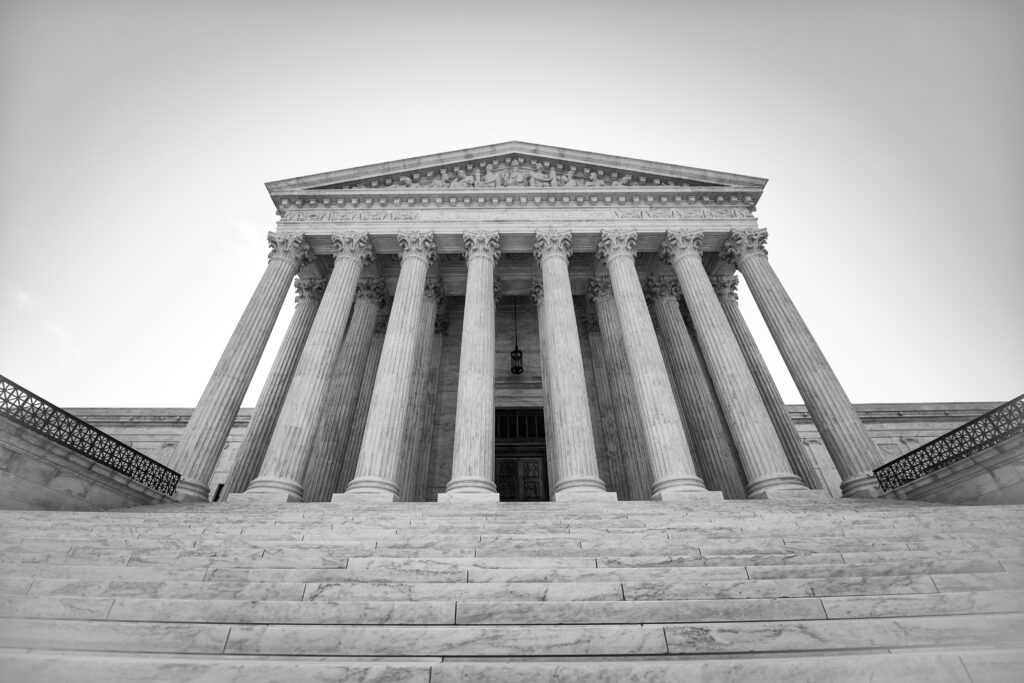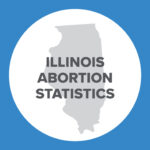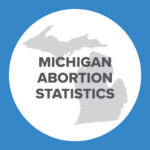Abortion Reporting: Kansas (2022)
This June, Kansas released its 2022 in-state abortion data. The number of abortions performed on Kansas residents in other states may be updated as additional reports are received by the Kansas Department of Health and Environment.
Statistics and Changes in Kansas Abortions, 2021-2022

The report does not include information on Planned Parenthood’s Kansas abortion market share.
Abortion Totals and Trends
There were 12,318 abortions reported in Kansas in 2022 (12,317 reported in-state occurrences, and one reported out-of-state occurrence), a steep increase of 57 percent from 2021 (Fig. 1) driven by an influx of women from other states. Chemical abortions also increased markedly, rising by 38 percent from the previous year, making up a majority (60 percent) of all Kansas abortions in 2022. Kansas’ abortion rate rose by a staggering 57 percent, from 13.8 to 21.7 abortions per 1,000 women of childbearing age (Fig. 2). As of July 2023, 12 states have released 2022 abortion statistics, with nine states showing that abortions had increased from the previous year.
State Report Summary
Kansas has consistently reported a large number of abortions obtained by women from other states, but nonresident abortions increased significantly in 2022. A strong majority (69 percent) of the abortions performed in Kansas were on nonresident women or women from other countries, compared to 50 percent in 2021. Only thirty-one percent of Kansas abortions (including one on a Kansas woman who traveled out-of-state for her abortion) were on Kansas residents.
Ten percent of Kansas abortions were performed on girls under the age of 20, including two percent performed on girls under the age of 18. Thirty-two percent were performed on women ages 20 to 24, and 27 percent were on women ages 25 to 29. Twenty-eight percent of Kansas abortions were obtained by women in their thirties (18 percent on women ages 30 to 34 and 10 percent on women ages 35 to 39), and three percent were on women ages 40 and older.
Just over one third of the abortions (37 percent) were performed on non-Hispanic white women. Just under a quarter (24 percent) were obtained by non-Hispanic black women, and four percent were on Asian or Pacific Islander women. Two percent were performed on Native American women, and four percent on women of other races. Twenty-eight percent of Kansas abortions were performed on Hispanic women of any race. Race was not reported for 120 abortions performed in Kansas in 2022.
The Kansas non-Hispanic black abortion rate, 87.7 abortions per 1,000 women ages 15 to 44, was the highest in the nation for 2022 and higher than any other state’s black abortion rate in 2021. It was eight times the Kansas non-Hispanic white abortion rate of 11.4. The 48.1 percent increase in the Kansas non-Hispanic black abortion rate from 2021 to 2022 is likely due to the large increase in out-of-state women who obtained abortions in Kansas in 2022. (The out-of-state resident total in 2021 was 3,912, compared to 8,475 in 2022.)
Eighty-three percent of Kansas abortions were performed on unmarried women, compared to only 14 percent on married women. Three percent were performed on women of unknown marital status. Seventy percent of the women had been pregnant before: over 19 percent of the abortions were performed on women with one prior pregnancy, and 50 percent on women with two or more previous pregnancies. Twenty-one percent of the abortions were performed on women with one previous abortion, and 10 percent on women with more than one. Nineteen percent of the abortions were obtained by women who had previously suffered at least one miscarriage, and 59 percent were performed on women with one or more living children. In contrast, 30 percent of Kansas abortions were on women with no previous pregnancies,69 percent on women with no previous abortions, 41 percent on women with no living children, and 81 percent on women with no prior miscarriages.
In 2022, 60 percent of Kansas abortions were chemical; all but three were induced with mifepristone, while the remaining three were induced using methotrexate. Thirty-five percent of the abortions were conducted via suction curettage, and five percent were dilation and evacuation procedures. There were 146 digoxin induction abortions, an increase from just 17 the year before. There were two sharp curettage abortions.
Sixty percent of Kansas abortions were performed before nine weeks gestation. Over a quarter (29 percent) occurred between nine and 12 weeks, while eight percent were performed between 13 and 16 weeks and four percent between 17 and 21 weeks. One abortion was performed at 22 weeks or later. Kansas limits abortion at 20 weeks post-fertilization, approximately 22 weeks gestation, except in cases where a mother’s life or physical health is seriously endangered by her pregnancy. According to the 2022 report, this post-22 week abortion was performed on an out-of-state resident to “prevent substantial and irreversible impairment of a major bodily function,” language drawn from the aforementioned statute). The unborn child had “agonal cardiac activity” (slow and irregular heart rhythms typically associated with dying patients), was not moving, and was not judged to be viable.
Of the abortions performed in Kansas, ultrasounds and sonograms were reported to have been used to determine gestational age in almost 100 percent of the cases. Ultrasound and last menstrual period (LMP) were used in one case, while LMP calculations were used in 10 cases, and in 19 cases, the method of gestational age determination was not reported. In one instance, the gestational age of the unborn child was not determined prior to the abortion.
Kansas requires medical professionals to file a report when they encounter a minor who is a victim of abuse or neglect (300 abortions were performed on minors in Kansas in 2022). In 2022, 76 abortion reporting forms indicated that a report of abuse or neglect had been filed.
Nonresident Abortions
Of the nonresident abortions performed in Kansas (8,475 in total), 35 percent were obtained by Texas women. Texas resident abortions increased 1,178 percent from just 233 in 2021 and comprised 24 percent of all Kansas abortions. Missouri resident abortions composed 34 percent of the nonresident total, and Oklahoma women composed 24 percent. Arkansas women made up five percent of the nonresident total.
Relatedly, a new abortion center opened in Kansas City, Kansas on June 28, 2022, four days after the United States Supreme Court overturned Roe v. Wade. The Wyandotte Health Center, operated by Planned Parenthood, is the fifth abortion center in the state, three of which are Planned Parenthood centers. This new center offers the abortion pill up to 11 weeks after the first day of a woman’s last menstrual period and surgical abortion up to 21 weeks and six days LMP. The center has reported that they have been “inundated” with calls from Missouri, Texas, Oklahoma, and Arkansas women, which is consistent with the statistics in Kansas’ 2022 abortion report.
Legislative Changes
The overturning of Roe by the U.S. Supreme Court in June 2022 did not affect abortion access in Kansas, since a prior ruling from Kansas’ state supreme court found a right to abortion in the Kansas constitution. In August 2022, a proposed constitutional amendment, titled “Value Them Both” (HCR 5003), was rejected by a vote of 59 percent to 41 percent. If passed, the amendment would have affirmed that the state’s constitution did not establish a right to an abortion or a right to require government funding of abortion. The amendment would have also given the Kansas legislature the power and right to regulate abortion.
In April 2023, the Kansas legislature overrode Governor Laura Kelly’s veto of HB 2313, the Born-alive Infants Protection Act. HB 2313 requires that health care providers give infants born alive after an abortion procedure the same level of care to preserve their life and health as they would give to any other child born alive at the same gestational age. The bill also mandates that born-alive infants be immediately transported to a hospital following the failed abortion and that any healthcare provider with knowledge of a failure to comply with this law report that failure to the appropriate law enforcement agency. Lastly, the bill contains criminal penalties, at the level of a felony, for any healthcare provider who knowingly violates this law. HB 2313 went into effect on July 1, 2023. In her overridden veto the Governor stated that the legislation was “[m]isleading and unnecessary” and that “[t]he intent of this bill is to intervene in medical decisions that should remain between doctors and their patients.”
State Ranking
In 2016, CLI evaluated abortion reporting across 50 states, New York City, and the District of Columbia, and Kansas’ reporting was tied for 15th best. Now that babies who survive abortions have been afforded greater protections under Kansas law, the state could improve its reporting by noting whether any babies are born alive during abortions and, if so, what becomes of the babies.
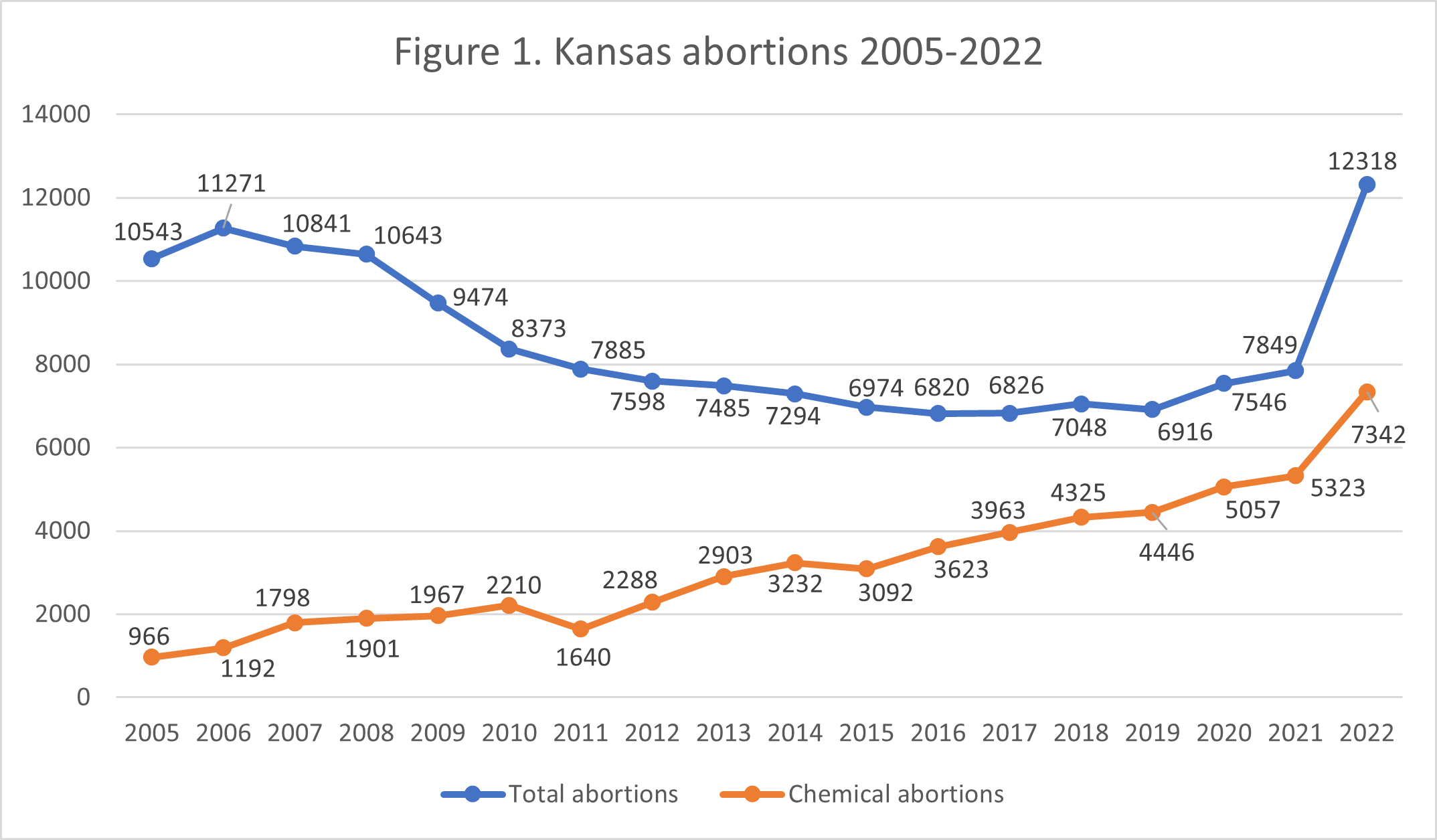
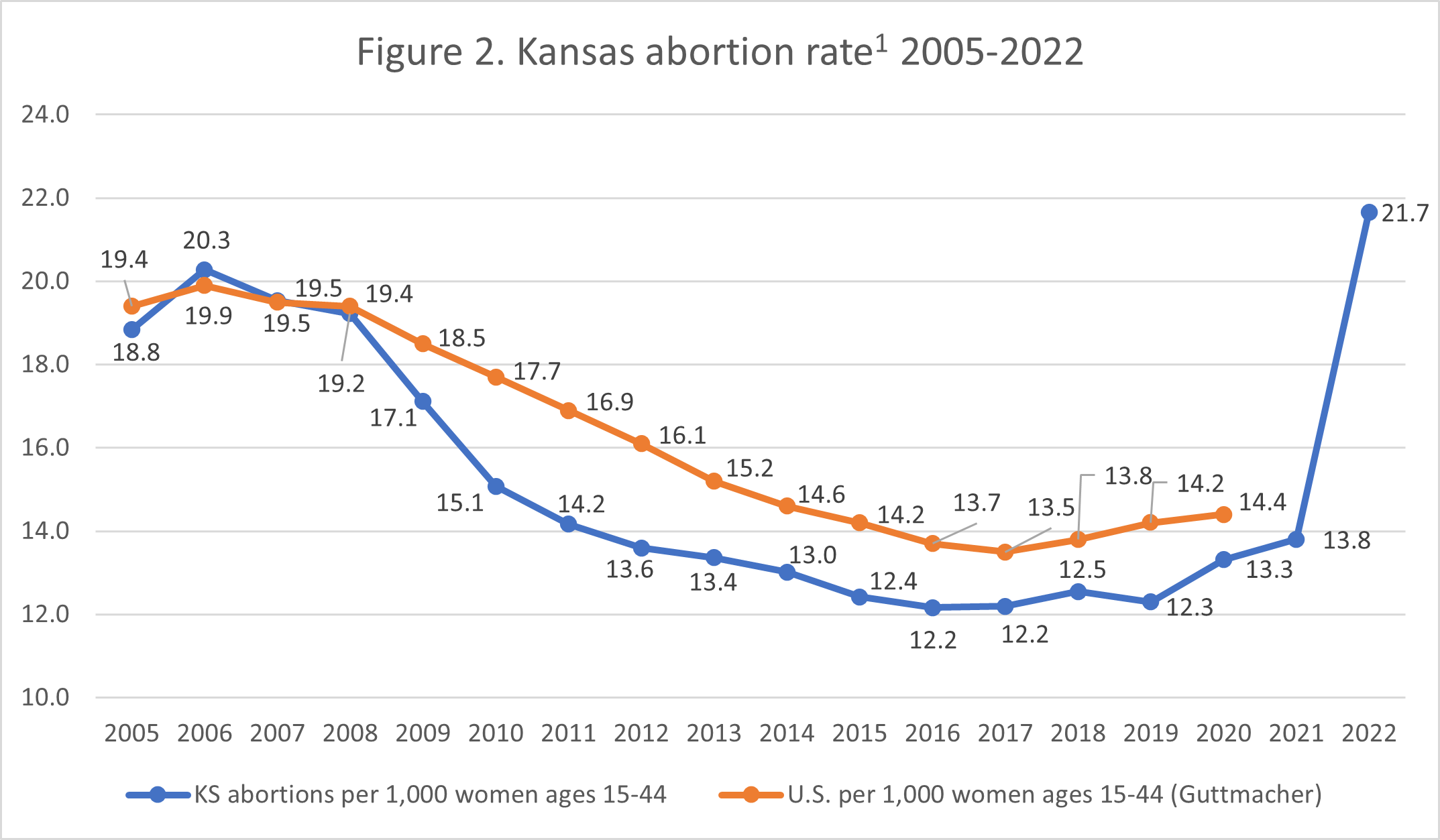
- Rates were calculated by CLI using the following formula: (total number of abortions reported by Kansas ÷ number of resident women ages 15 to 44) x 1,000. Rates may differ slightly from previous CLI articles due to revised population estimates. Population estimates were obtained from CDC WONDER. Estimates for 2005-2009 are intercensal estimates of the July 1 resident population. Estimates for 2010-2019 are Vintage 2020 postcensal estimates of the July 1 resident population. Estimates for 2020-2022 are Vintage 2021 postcensal estimates of the July 1 resident population as the CDC has not released 2022 population estimates yet. Estimates were produced by the U.S. Census Bureau and the National Center for Health Statistics.


















